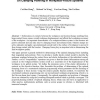Free Online Productivity Tools
i2Speak
i2Symbol
i2OCR
iTex2Img
iWeb2Print
iWeb2Shot
i2Type
iPdf2Split
iPdf2Merge
i2Bopomofo
i2Arabic
i2Style
i2Image
i2PDF
iLatex2Rtf
Sci2ools
TASE
2008
IEEE
2008
IEEE
On Clamping Planning in Workpiece-Fixture Systems
Deformation at contacts between the workpiece and locators/clamps resulting from large contact forces causes overall workpiece displacement, and affects the localization accuracy of the workpiece. An important characteristic of a workpiece-fixture system is that locators are passive elements and can only react to clamping forces and external loads, whereas clamps are active elements and apply a pre-determined normal load to the surface of workpiece to prevent it from losing contact with the locators. Clamping forces play an important role in determining the final workpiece quality. This paper presents a general method for determining of the optimal clamping forces including their magnitude and positions. First, we develop a locally elastic contact model to describe the nonlinear coupling between the contact force and elastic deformation at the individual contact. Further, a set of "compatibility" equations are given so that the elastic deformations among all contacts in the w...
Clamping Forces | Elastic Deformation | Optimal Clamping Forces | Software Engineering | TASE 2008 |
| Added | 15 Dec 2010 |
| Updated | 15 Dec 2010 |
| Type | Journal |
| Year | 2008 |
| Where | TASE |
| Authors | Caihua Xiong, Michael Yu Wang, You-Lun Xiong |
Comments (0)

